Menus
- The Water Box
- Discovery
- In the saddle
- Start-up
- First turns of the wheels
- In the city
- On the road
- On the highway
- In duet
- Braking
- Consumption
- Restoration
- Historical
- Production
- Chronology
- Coast side
- In case of purchase
- Conclusion
The Water Box
Introduced at the Tokyo Motor Show in 1971, the imposing Suzuki 750 GT had no shortage of strengths against the competition of the time…. Let us step back more than forty years. The Suz ’had an electric starter. A kicker as well. This was the case with the four-legged Honda, (the "purists" reproached him enough!), But except for these two monsters, the driver of the competitors of the day still had to work his legs to shake his pistons. Dame GT was also the first to opt for liquid cooling (except the distant Scott in the 1920s and the Velocette LE in 1953). "Water cooled", we read on the crankcases. The dashboard also attests to this, with its water temperature dial placed between the speedometer and tachometer. The process had the advantage of eliminating any risk of clamping, on the largest two-stroke engine ever built ….
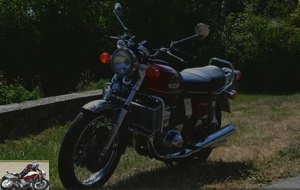
Discovery
A very nice machine. Three legs, but four mufflers (the middle one doubles up), to provide perfect visual balance. Chromes in abundance, stylish lights and indicators, perfectly designed engine block and conquering radiator, no doubt, the 750 GT attracts the eye of passers-by and remains a very rewarding machine today..
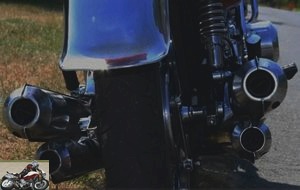
In the saddle
Massive, the GT 750 imposes it. But once on board, between the comfort of the buttocks and the eyes on the three counters, you immediately feel at home. Handlebars well positioned, only the footrests seem a little forward ….
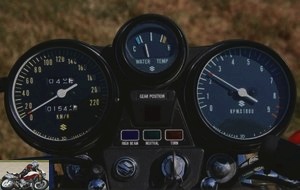
Start-up
Crank or starter? The engine starts à la carte. You don’t have to have a rugby’s thigh to kick in, a three-cylinder two-stroke can come to life in your hand. Or with a thumb, by pressing the "start" button and it is much more convenient.
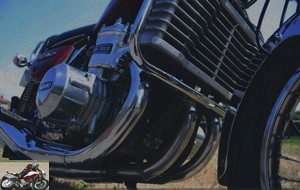
Once on the road, what comfort. First, it works thanks to the silent blocks on which the engine rests. Certainly, we can see it moving, but without feeling the slightest vibration. And no pan noise either, despite the type of thruster, the music filtered by the four exhausts remains quite audible, even pleasant in full acceleration ….
First turns of the wheels
Declared clumsy when released, the Suzuki actually turns out to be a lot more maneuverable than it looks. In addition, blue smoke emissions remain limited and do not risk bothering pedestrians with asthma..
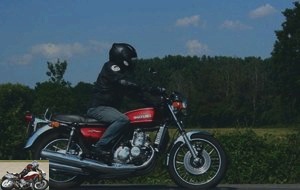
In the city
Without being as agile as an alley cat, the big Suzuki allows itself some daring convolutions between the lines of cars without laboring outrageously. Relatively low, maneuvering at a standstill is hardly a problem and the engine, even in scorching weather, always stays at a constant temperature. Moreover, the fan intended to cool the block of the first models was quickly removed by the manufacturer ….
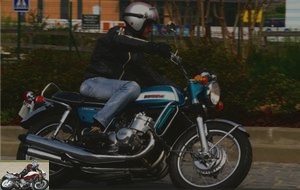
On the road
The rear suspensions allow the rider to imagine the joys of rodeo on bumpy roads. If the coating is good, the GT can be handled with softness and precision, well helped by its engine, capable of resuming in fifth from 2000 laps. The accelerations are dazzling (and accompanied by lovely bluish scrolls), enough to exceed the endless lines of cars in a half-turn of the gas handful. In the rain, or in succession of tight bends, it is advisable to take into account the total absence of engine braking, the absence of valves obliges ….
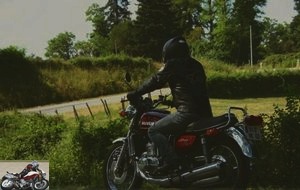
On the highway
Perfect heading hold, even once the prohibited speeds are reached. The dashboard deflects the turbulence a little, but beyond 150 km / h, the cervical necks would gladly claim a protective neck brace. Some approximations in long curves, fault of the faulty shock absorbers, but nothing really alarming ….
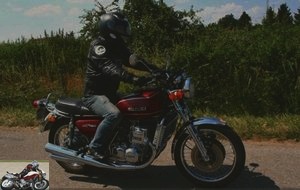
In duet
The motorcycle of couples who last…. Comfortable, spacious saddle, grab bar, not the slightest vibration, suspended footrests. Great luxury. Too bad the suspensions are so rough.
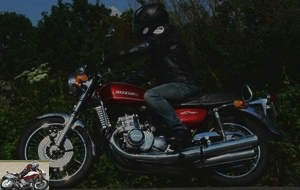
Braking
Regarding braking, the double front disc does not risk ejecting the pilot over the machine, but it does the minimum union. Not much better than the double cams of the initial model (now the most sought after!), But in 72, the year of distribution of the first GTs in France, offering a limousine slowed down by a front drum trampled the dignity of bikers so much that the importer ended up agreeing to exchange them for free.
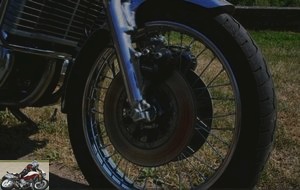
Consumption
Surprise, the big three-cylinder two-stroke consumes little. 8l / 100 full blast on the highway. On average 7 liters and the oil tank, with a capacity of 1.8l, does not empty until after more than 1000 kilometers ….
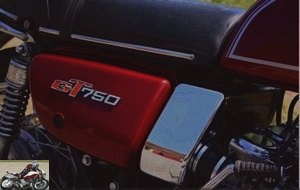
Restoration
The 76 vintage of this test was restored from A to Z. No major difficulty for a good repair, 80% of the parts are still available in the Suzuki network. Only oil pump and turbine require more research. In addition, the mechanical architecture of the "Hot Water Bottle", very well designed, does not require any special tools or expert knowledge, before undertaking a visit to its bowels..
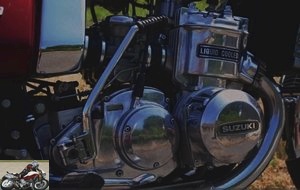
Historical
Over the course of his career, which was interrupted (far too early!) In 1977, the hot water bottle has seen few changes. Well born, of exemplary reliability, the few modifications touched nothing essential. In 74, the fan was removed. Appearance of vacuum carbs, passage from 67 to 71 horses and improvement of the ground clearance by rolling up its flutes. The dashboard will also be redesigned with the addition of a gear indicator, new side covers and later a hatch will hide the fuel cap ….
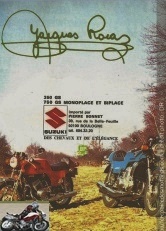 In fact, the real thunderclap came through Jacques Roca, then technical director at Suzuki France, a talented former driver and skilful trainer. Faced with disappointing sales of the 750 GT and in an attempt to sell off part of the reserve stock, he will have the idea of radically modifying it. A kind of slimming cure (on the scale, only 14 kilos lost) and a complete makeover. To achieve this, polyester shell cover, the pipes raised and add to all that a small engine inflation, intervening on the skirts of the pistons and carburettors in order to modify the diagram. Without becoming a bomb, thus boosted, the "Rocazuki" was familiar to 200 km / h and its pace was (a little) similar to the formidable TR 750, racing variation of the GT, on which Barry Sheene, everyone’s idol. , had conquered the title of European champion. The plan worked well and the controls relieved the bulky surplus for a while, but it seemed clear that the career of this astonishing three-cylinder had lead in the wing, especially as in the United States the standards anti-pollution were soon to ban, purely and simply, two-stroke engines ….
In fact, the real thunderclap came through Jacques Roca, then technical director at Suzuki France, a talented former driver and skilful trainer. Faced with disappointing sales of the 750 GT and in an attempt to sell off part of the reserve stock, he will have the idea of radically modifying it. A kind of slimming cure (on the scale, only 14 kilos lost) and a complete makeover. To achieve this, polyester shell cover, the pipes raised and add to all that a small engine inflation, intervening on the skirts of the pistons and carburettors in order to modify the diagram. Without becoming a bomb, thus boosted, the "Rocazuki" was familiar to 200 km / h and its pace was (a little) similar to the formidable TR 750, racing variation of the GT, on which Barry Sheene, everyone’s idol. , had conquered the title of European champion. The plan worked well and the controls relieved the bulky surplus for a while, but it seemed clear that the career of this astonishing three-cylinder had lead in the wing, especially as in the United States the standards anti-pollution were soon to ban, purely and simply, two-stroke engines ….
Production
Shortly before the presentation of the Kawasaki H2 750, Suzuki unveiled its new model, the GT 750. The first motorcycle to feature a liquid-cooled two-stroke three-cylinder engine. Nicknamed "the hot water bottle" in Europe and "water Buffalo" in the USA, it was presented at the Paris Motor Show in October 1971. Marketed in France in January 1972 (model J), the GT was produced in around 45,000 copies worldwide. . Without knowing the expected success, she ended her career in 1977 with the last model B.
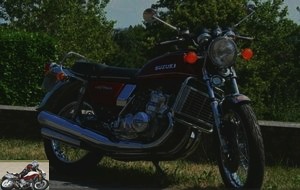
Chronology
- 1972 : Type J colors: Purple and Turquoise, power 67 hp, front 4-cam drum brakes
- 1973 : Type K colors: Old gold metallic and Blue, front double disc brakes. Chrome radiator sides, new stems, front turn signal mounts on the headlight brackets and recessed.
- 1974 : Type Color: Blue and Red, the pots lose their cones and are no longer connected, flexible brake hoses, no more fork bellows, new counter / tachometer with the appearance of the gear indicator engaged, new bodywork, vacuum carburettors, fan removed, the radiator receives a plastic covering and the sides disappear, plus a new air filter housing. Power 71 CV, longer gear ratio, the cylinder block receives “Liquid cooled” stickers, the frame is reinforced at the level of the crutch.
- 1975 : Type M color Gray and Red, new tank decorations.
- 1976 : Type A orange and blue colors, arrival of the locking fuel tank hatch, new fuel tank decorations.
- 1977 : Type B colors: Black, Blue and Red, new front mudguard, disappearance of the reinforcement rods, new indicators, the headlight brackets and the side covers become black, the side reflectors are no longer on the indicators but on the support rear light and front on the headlight brackets, new tank decorations.
- A Police version also saw the light of day, as well as the GTs modified by Jacques Roca.
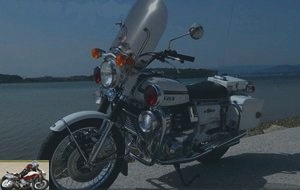
Coast side
The Suzuki GT 750 was displayed at the dealer at 12,900 Frs (or € 1,966). Today, to acquire a fully restored Suzuki GT 750 or, more rarely, in original and complete condition, you will have to pay between 10,000 and 15,000 €. A tidy sum that takes into account the quality of the restoration and the parts replaced. The rarest model (J Drum Violine), strictly original and in perfect condition, can cost around € 18,000.
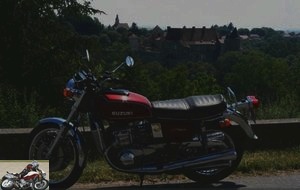
In case of purchase
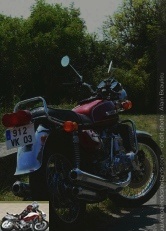 You will be able to acquire a restored machine by taking care to verify the quality of the work and the origin of the parts used. The passion of the owner and the supported invoices are always good clues. Take the time to test the bike well in order to track down the slightest suspicious noise and to check that all the components are working properly. On a motorcycle that has been stored for a long time, the connecting rods can be marked and the crankshaft seals will have to be replaced, requiring a complete disassembly of the engine and its total overhaul. The water pump should be monitored, just like the oil pump and its flow rate. The clutch bell is recognized to be a bit fragile and the 3rd clutch dogs tend to age badly. To be able to fully exploit this fabulous engine, the carburetion must be adjusted regularly according to the gasoline used.
You will be able to acquire a restored machine by taking care to verify the quality of the work and the origin of the parts used. The passion of the owner and the supported invoices are always good clues. Take the time to test the bike well in order to track down the slightest suspicious noise and to check that all the components are working properly. On a motorcycle that has been stored for a long time, the connecting rods can be marked and the crankshaft seals will have to be replaced, requiring a complete disassembly of the engine and its total overhaul. The water pump should be monitored, just like the oil pump and its flow rate. The clutch bell is recognized to be a bit fragile and the 3rd clutch dogs tend to age badly. To be able to fully exploit this fabulous engine, the carburetion must be adjusted regularly according to the gasoline used.
Conclusion
Today, the sublime Suzuki is a much sought-after motorcycle. Long underestimated, even in collections, it is now reaching new heights as its prestige is immense. Majestic, efficient, inevitably unique and always ready to go, the misunderstood yesterday has transformed into an extremely respectable grande dame, as pleasant to drive as to watch ….
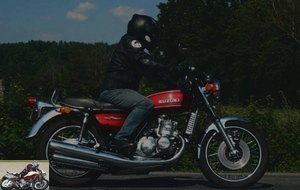
Strong points
- duo
Weak points
- protection
- braking
The technical sheet of the Suzuki GT 750
Related articles
-
In-line twin, 471 cm3, 45 hp at 8,500 rpm, 44.6 Nm at 6,000 rpm, 190 kilos, € 6,299 A small accessible bobber intended for A2 licenses on a mechanical…
-
Flatteries of flat Appeared forty years ago (already!), The Honda 1000 GoldWing was the first behemoth produced in large series. A limousine on two…
-
The school of fans (of speed) KTM hits hard with its RC 390 by offering the most efficient machine in the A2 segment. Easy and fun while remaining very…
-
Triumph Bonneville Bobber Black test
2 cylinders in line, 1200 cc, 77 hp at 6100 rpm, 106 Nm at 4000 rpm, 237.5 kilos dry, from ¤ 14 350 More muscle, more techno, more dark for the Bobber Is…
-
Birthday 4 cylinders in line, 1000 cm3, 202 hp, 117 Nm, 203 kg all full facts, 19,599 euros. Nice idea to resuscitate the R version of the GSX-R (the…
-
Madam DR ax ! At the beginning of the 80s, trail running was in vogue, sales exploded and manufacturers waged a merciless war by offering increasingly…
-
900 new blood ! Praised since its presentation in 1972, the 900 Z1 Kawasaki has now become a legend …. A little history Imagined by Sam Tanegashima, an…
-
Gentleman Badass Triumph reinvents its flagship model, the Bonneville, in two versions, 900 Street Twin and T120 cubing 1200 cm3, succeeding the T100….
-
The unfinished future The brand with three tuning forks, wishing to prove its lead in terms of technology and innovation, unveiled its 1000 GTS at the…
-
Harley-Davidson Forty-Eight and A2 test
1202 cm3, approx. 60 horsepower at 5500 rpm, 96 Nm at 3500 rpm, 252 kilos with full tank, from 12,410 € A minimalist and very stylish machine, generous…
It is not my category of motorcycle either, but personally, I find it rather pretty.
And the technical characteristics are to die for.
Afterwards, in terms of daily use … except for doing the circuit every week and not wanting a sportswoman for the other days, I have trouble justifying such a purchase (unless the money doesn’t count): It’s still a bit of a binge of energy for the city (I know, there are fashions and all, but what I mean is that it won’t do anything better than ‘a more … reasonable model), no protection for driving, excessive for arsouilles on departmental roads (at least for my level of driving!)…
But once I said all that I would add that I wouldn’t cry if I had it in my garage 🙂
For an original exhaust I find it very successful, more than choosing its sticker to put on it!
Like what it is possible to control the consumption on a powerful motorcycle.
It would be good for Yamaha to take lessons at Triumph !!!
She remains pretty but no longer has the face she had, with the 2 pots under the saddle.
Beautiful machine
I like the fact that the Speed remains a road roadster.
Well, a Sprint ST variant, with a little racer semi fairing and a real two-seater saddle, even with 20 kg more, I won’t spit on it. Sandrine neither, I think.
Roadster that has class if we compare to the orange alternative Superduke, less ostentatious and above all less expensive than the red Streetfighter V4 S for which we almost feel obliged to add the exhaust line to more than 5000 EUR for a real nice noise (you can exceed 30,000 EUR on the Ducati configurator) and served by a larger network than at Aprilia. I tried the triple RS 2 years ago, the Triumph 3 cylinder is really nice compared to the low end roughness of the Ducati twins I have used so far. Power and torque of a twin cylinder and flexibility of 4 in line (without being bland). So I gave in and ordered this beautiful machine, not yet feeling ready to go on a trail after the Panigale. This speed triple is for me the most beautiful of current roadsters. This is obviously very subjective … It obviously does not have the practical side of the latest trails but can connect its smartphone for a navigation function, which would have thought of that on a sporty roadster 3 or 4 years ago. Nice try. I just hope the suspension won’t be too painful to adjust given the various testers’ comments.
It would look more "finished" with a fork head rather than those two filthy warts that serve as headlights …
Yes, but it’s still his visual signature for 20 years.
Nice report, thank you. A very nice bike, but the wooden saddle, the capacity of the tank (to display a lower weight), a less torquey engine at the bottom just to gain power with the key to a higher price: the account is not there. is more (definitely) for me. Too bad for the abandonment of the high pots which also made the identity of the bike. 300 km of autonomy with a speed, I have a big doubt.
Le Grau, Port Camargue, the feral ferry, Saintes Maries …
A superb sun …
Lucky guys
15.5L the tank … I know that the weight is a marketing argument, and that today people drive little and not far, but all the same … my Speed Triple 1994 was 25L and did not consume more. .. admittedly it was a bit heavier, and not just junk;)
I fear that this exclusively circuit presentation will mask the cruel reality of an infernally hard suspension on a slightly degraded road….
On the bumpy, my Speed was almost untenable as it bounced in all directions, and given the direction of development of the R, it is not these Цhlins that will solve the problem.!
: -S
Why orient a roadster circuit which normally will circulate as a priority on the road??
Why turn off ABS on the track? Is he that bad? Honda and BMW keep him active on the CBR and S1000RR…
And the shock absorber is not a "real" TTX36, since there is no hydraulic adjustment of the preload, nor the double adjustment of slow / fast compression.
And it is all the same strange that Triumph persists in not modifying the spring preload in "duo" use, whereas this is logically the first modification to be made to the suspension settings to keep the trim!